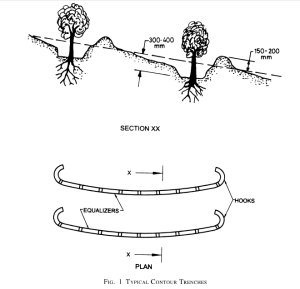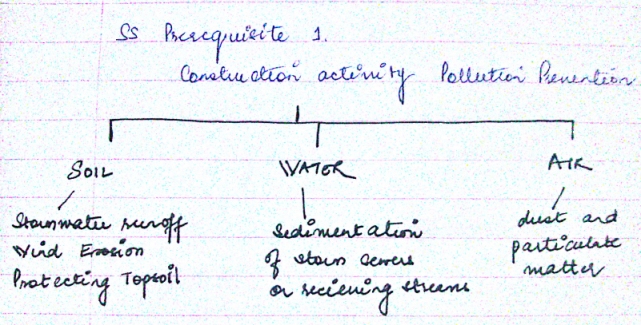Intent
To reduce pollution from construction activities by controlling soil erosion, waterway sedimentation and airborne dust generation.
Requirements
Create and implement an erosion and sedimentation control plan for all construction activities associated with the project. The plan must conform to erosion and sedimentation control requirements of Local Standards and Codes (OR) National Building Code of India (NBC), Part 10, Section 1, Chapters 4 & 5, whichever is more stringent.
Potential Technologies & Strategies
Create an erosion and sedimentation control plan during the design phase of the project.
Consider employing strategies such as temporary and permanent seeding, mulching, earthen dikes, silt fencing, sediment traps and sediment basins.
National Building Codes of India (NBC) Part 10, section 1, chapter 4 – Protection of Landscape during Construction and chapter 5 – Soil and Water Conservation.
1. Timing of Construction
Construction work and erosion control applications shall be scheduled and sequenced during dry weather periods when the potential for erosion is the lowest.
Slope protection techniques to control erosion shall be used when construction during wet season is unavoidable.
2. Preservation of Existing Vegetation
This practice minimizes the amount of bare soil exposed to erosive forces.
All existing vegetation shall be marked on a site survey plan. The landscape plan should indicate trees, which have been preserved, and also those, which had to be transplanted or removed clearly differentiating between these three categories.
Damage to roots shall be prevented during trenching, placing backfill, driving or parking heavy equipment, dumping of trash, oil, paint, and other materials detrimental to plant health by restricting these activities to outside the area of the canopy of the tree.
Trees will not be used for support; their trunks shall not be damaged by cutting and carving or by nailing posters, advertisements or other material.
Lighting of fires or carrying out heat or gas emitting construction activity within the ground, covered by canopy of the tree shall
not be permitted.
Young trees or saplings identified for preservation (height less than 2.00 m, 0.10 m trunk girth at 1.00 m height from finish
ground, 2.00 m crown diameter) within the construction site have to be protected using tree guards of approved specification.
Existing drainage patterns through or into any preservation area shall not be modified unless specifically directed by the Landscape Architect/Architect/Engineer-in-charge.
Existing grades shall be maintained around existing vegetation and lowering or raising the levels around the vegetation is not allowed unless specifically directed by the Landscape Architect/Architect/Engineer-in-charge.
3. Staging Areas
Measures shall be followed for collecting runoff from construction areas and material storage sites; diverting water flow away from such polluted areas, so that pollutants do not mix with storm water runoff from undisturbed areas.
Temporary drainage channels, perimeter dike/swale, etc shall be constructed to carry the pollutant-laden water directly to treatment device or facility. The plan shall indicate how the above is accomplished on site, well in advance of the commencing of the construction activity.
4. Preservation of Topsoil
Topsoil removal and preservation shall be mandatory for development projects larger than 1.00 hectare.
Topsoil shall be stripped to a depth of 200 mm from areas proposed to be occupied by buildings, roads, paved areas and external services.
It shall be stockpiled to a height of 400 mm in designated areas and shall be re-applied to site during plantation of the proposed vegetation. Topsoil shall be separated from sub-soil debris and stones larger than 50 mm diameter. The stored topsoil may be used as finished grade for planting areas.
5. Spill Prevention and Control
Spill prevention and control plans shall be made, clearly stating measures to stop the source of the spill, to contain the spill, to dispose the contaminated material and hazardous wastes, and stating designation of personnel trained to prevent and control spills. Hazardous wastes include pesticides, paints, cleaners, petroleum products, fertilizers and solvents.
6. Sedimentation Basin
A temporary dam or basin at the lowest point of the site has to be constructed for collecting, trapping and storing sediment produced by the construction activities, together with a flow detention facility for reducing peak runoff rates. This would allow most of the sediments to settle before the runoff is directed towards the outfall.
7. Contour Trenching
Contour trenching is an earth embankment or ridge-and-channel arrangement constructed parallel to the contours along the face of the slope at regular intervals on long and steep slopes (in sloping areas with slopes greater than 10 percent) . They are used for
reducing runoff velocity, increasing the distance of overland runoff flow, and to hold moisture and minimize sediment loading of surface runoff.
Vegetative cover of tree and native grasses in the channels may be planted to stabilize the slopes and reduce erosion.

8. Mulching
Mulching shall be used with seeding and planting in steep slope areas (slopes greater than 33 percent) that are prone to heavy erosion. Netting or anchoring shall be used to hold it in place. Other surface runoff control measures like contour terracing to break up concentrated flows shall be installed prior to seeding and mulching. Materials such as straw, grass, grass hay and compost shall be placed on or incorporated into the soil surface. In addition to stabilizing soils, mulching will reduce the storm water runoff over an area. Together with seeding or planting, mulching aids plant growth by holding the seed, fertilizers and topsoil in place. It retains moisture and insulates the soil against extreme temperatures.
9. Geo-grids
A deformed or non-deformed net like polymeric material used with foundation, soil, rock, earth or any other gee-technical engineering-related material as an integral part of the human-made project structure or system, called geo-grids may be used as control measure. On filling with lightly compacted soil or fine aggregate, a monolithic structure is created providing an effective means of confinement for unconsolidated materials within the cells and preventing their movement even on steep slopes. If required the area can then be seeded to maintain ‘green’ environment. he junctions have a central opening through which water can permeate ensuring that organic material receives moisture for rapid growth.
OVERVIEW: SS Prerequisite One.
